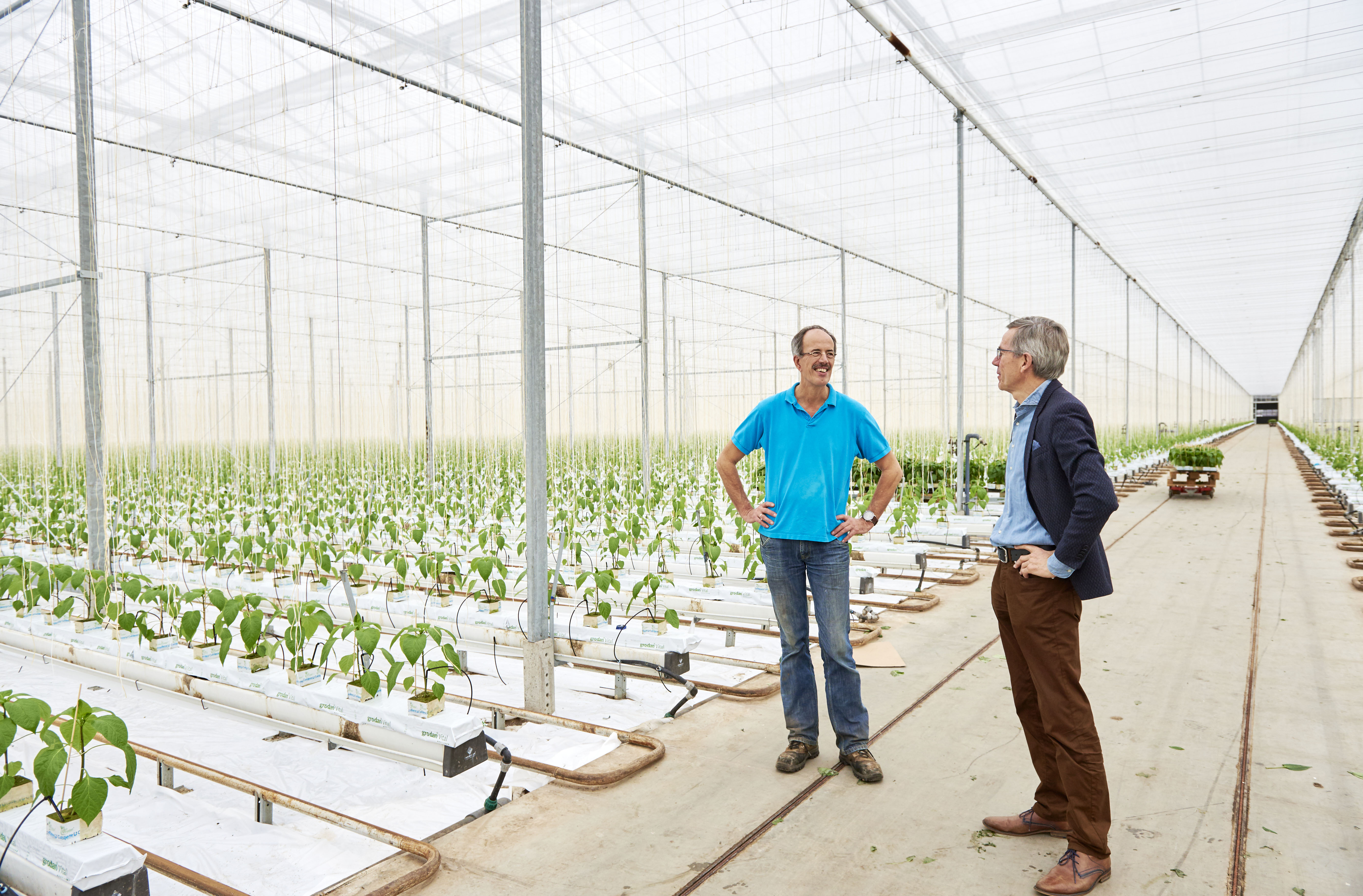和斯文森高级顾问Hugo Plaisier的一天
斯文森的顾问团队是对外交流很重要的部分,因为种植者,安装商以及现代育种专家对于气候幕布领域的最新发展动向都非常感兴趣。Hugo Plaisier主要负责荷兰Noordoostpolder地区的顾问工作。
07:00/08:00
这是早出晚归的一天,下午的降雪可能会导致交通堵塞。Hugo早晨就开始准备两位客户的拜访,这也是在为明天斯文森荷兰分公司销售会议做准备。
10:30
首先,Hugo从位于Barendrecht的家驱车前往位于IJsselmuiden的Noorland,Kampen对面的一个小村庄,拜访一位青椒种植者,路上大概需要2个小时左右。Ton和Jan Noorland兄弟两人终于完成了最初的梦想:拥有一间7公顷的青椒种植温室。

12:00
Hugo在A28路上的Routiers餐厅简单的吃了些面包和汤又继续赶路了。他此行的目的是想了解下两兄弟最近安装的第二层幕布,斯文森全新的Luxous 1147 FR的情况。这款节能幕布是专门为蔬菜种植设计的,具有极高的透光率。种植青椒需要较多的光照,而斯文森推出这款全新的幕布后,Noorland成为了首批尝试使用的用户之一。
13:00 (1:00 PM)
Hugo到达了Noorland温室的办公室,Ton从餐厅取来咖啡,两人便开始交流幕布安装的情况。此刻,Jan正在温室里忙着定植青椒植株(Enza Zaden的Frazier品种等)和连接滴灌管,基质使用的是Grodan Vital。当他完成的时候,温室的植株总数将会超过130000株。每个植株会分出两个枝干,黄色的绳子用来牵引主干,白色的则用来支撑侧枝,使他们向上生长,预计从三月中期开始收获。
“能源的成本很高,而高效的使用幕布能够节约天然气,”Ton向我们解释使用第二层幕布的益处:“选择安装全新的Luxous是因为我不想使用铝箔型的幕布,每次更换幕布都要花费很多的人力。我想直接安装最前沿的新幕布。”Hugo对此表示极为赞同。使用两层幕布来节能的效果真的比之前好太多了。Ton和Hugo计算了一下,使用两层幕布后可以很容易实现每平米30立方米的天然气,但是Ton还听说另一个青椒种植者仅需要每平米27立方米多一点的天然气使用量,他也希望可以尽可能多的节能。
“节约能源成本可以让我们获得更多的利润,而在过去的几年中,青椒每公斤的利润越来越低。使用高透光型的幕布可以提高单位产量,因为植株可以获得更多的光照。”Ton在温室参观后将Hugo拉到一旁,向他询问起置换已经使用了10年的第一层幕布的事,他希望通过更换幕布可以实现最大化的节能效果。Hugo许诺会跟进此事,但是还是需要先看看使用全新的Luxous 1147 FR的效果如何。
15:20 (3:30 PM)
施工会议由Allefs主持,坐在他旁边的是外源技术顾问Theo Herngreen,另外还有4位将会在温室工作的研究人员。Hugo面前挂在墙上的是温室设计建造者Certhon绘制的建筑结构图。Herngreen和Certhon一起概述了图中涉及的各种幕布,他们希望Hugo可以帮助他们看看选择的幕布是否能够为劳动者创造一个舒适的工作环境,是否可以防止光污染。
Allefs补充说:“我们使用幕布是为了优化我们的环境,让我们的研究人员在温室中感觉凉爽,而我们的植物又需要光照和空气,同时也要考虑节能的问题。”Theo,Sjefke和Hugo一同讨论了温室的各个区域,很多参考的文档摆在桌上,研究人员也会时而参与到讨论中。Hugo在一些幕布方面的小细节调整上给出了建议,但是并不会影响温室整个结构。Sjefke Allefs密切关注着施工的进度。
幕布会在7月底进行安装,温室将于2018年初竣工。Hugo表示之后在幕布的使用过程中,他还会来这里和使用者一同讨论如何科学的使用幕布。
16:30 (4:30 PM)
Hugo准备离开Agrico Research的时候,天色已经暗下来了,地图上显示归途的路线有些拥堵。荷兰就是如此,一下雪,整个交通就瘫痪了。于是,他先给斯文森商业总监Wouter de Jong打了个电话,告诉他客户的合作意愿,“我会去看看Agrico需要的品种是否有库存,”他告诉Wouter:“毕竟,这不是斯文森典型的客户,但是他觉得下午的会谈是非常有意义的。” Hugo打电话告诉他的妻子7点不能回去做饭了,因为交通的问题。回家后,他和斯文森气候分析师兼产品经理Paul Arkesteijn讨论了和Noorland的会面情况。
“With Svensson's newest climate screen, Harmony 1315 O FR, lighting tomato growers can get through the worst of climates, even a record hot summer like in 2018,” says greenhouse climate consultant Joost Haenen.
The new open climate screen offers benefits not only for the plants, but also for the working climate conditions. The best part of this new screen is that it makes chalking or coating unnecessary.
The major challenge in every crop lies in the realization of a good assimilate balance. In other words, the production of assimilates (controlled by irradiation) and the consumption of assimilates (depending on temperature) must be in balance. During a heat wave such as our past summer, the temperature is high, and therefore the consumption of assimilates is high. Too high consumption of assimilates comes at the expense of the roots. Weak or uneven root growth can lead to quality problems and water stress during a heat wave with a lot of radiation, causing high evaporation. This will close the stomata. However, open stomata are necessary for CO2 absorption. As a result, not only growth comes to a halt, but also less moisture enters the greenhouse air. This can easily be avoided with the right ventilation strategy but preventing plant stress is even better. The Harmony 1315 O FR summer screen has been developed for this purpose.
Specially for exposed tomato cultivation
High light levels and air permeability are unique to the Harmony 1315 O FR summer screen. When closed, it provides a slight shadow effect (13% in direct light) and a very high diffusivity. The screen has been specially developed for illuminated tomato growing. Tomatoes can have a lot of light, but at some point, they can't handle it anymore. This climate screen has been developed to remove the sharp edges. Especially in the scarce warm months, April to July, when the plant is old and has long stems.
“Tests at the Improvement Center have shown that the plant does not have to evaporate as much on an extremely sunny day with the new screen. The water consumption is then approximately 20% lower, which means that the root quality remains better due to oxygen retention in the mat. The open structure is also unique, ensuring that there is more than enough air exchange. That's why it's a perfect screen for the summer," says climate consultant Joost Haenen. “Moreover, the cultivation plan changes from tomato. Lighting growers are planting plants earlier and earlier, sometimes in August or even in July. Small plants then have a hard time due to the high radiation and temperature. During this period, the climate screen can easily be used to keep the plant in balance."
存在疑问?
联系斯文森的咨询顾问